Table of Contents
Electric Motor Maintenance and Troubleshooting
Electric motors should be installed, maintained and troubleshot by electricians. There are millions of motors in use in homes, offices, stores, and industrial plants. One major concern is choosing the right motor for a given job. The choice depends on the intended use of the motor, the availability of power, the location and other factors.
Once installed, the motor must be properly maintained to prevent problems. The electrician and apprentice should ensure proper motor maintenance, and if problems do occur, they should be able to pinpoint the source and cause of the problem and correct it. This chapter discusses preventive maintenance of electric motors and danger signals to recognize in motors, and hints for correcting common problems.
Preventive Maintenance of Electric Motor
Small motors usually operate with so little trouble that they are apt to be neglected. However, they should be thoroughly inspected twice a year to detect wear and to remove any conditions that might lead to further wear or cause trouble. Special care should be taken to inspect motor bearings, cutouts, and other parts subject to wear. Also, be sure that dirt and dust are not interfering with ventilation or clogging moving parts.
Checking and Maintaining Electric Motors
1. Be sure there is adequate wiring. After a motor has been installed or transferred from one location to another, check the wiring. Be sure that adequate wire sizes are used to feed electric power to the motor; in many cases, replacing wires is all that is needed to prevent future breakdowns. Adequate wiring also helps to prevent overheating and reduces electric power costs.
2. Check internal switches. Although switches usually give little trouble, regular attention will make them last longer. Use fine sandpaper to clean contacts. Be sure sliding members on a shaft move freely, and check for loose screws.
3. Check load conditions. Check the driven load regularly. Sometimes additional friction develops gradually within a
machine and after a period imposes an overload on the motor. Watch motor temperatures and protect motors with properly rated fuses or overload cutouts.
4. Provide extra care in lubrication. Motors should be lubricated according to manufacturer’s recommendations. A motor running three times more than usual needs three times more attention to lubrication. Provide enough oil, but don’t overdo it.
5. Keep commutators clean. Do not allow a commutator to become covered with dust or oil. Wipe it occasionally with a clean, dry cloth or one moistened with a solvent that does not leave a film. If it is necessary to use sandpaper to clean the commutator, use No. 0000 or finer.
6. Replace worn brushes. Inspect brushes at regular intervals. Whenever a brush is removed for inspection, be sure to replace it in the same axial position that is, it should not be turned around in the brush holder when it is put back in the motor. If the contact surface that has been worn in to fit the commutator is not replaced in the same position, excessive sparking and loss of power will result.
7. Brushes naturally wear down. They should be replaced before they are less than 1/4 inch long.
8. Be sure that the motor has a proper service rating. Whenever a motor is operated under different situations or used in a different way, be sure it is rated properly. Take, for example, a motor rated for intermittent duty because the temperature rise within the motor will not be excessive when it is operated for a short period. Putting such a motor on continuous duty will result in excessive temperature increases that will lead to burnout or at least to deterioration of the insulation.
Lubrication
As stated in the list in the previous section, extra care in lubrication is essential in maintaining all motors. The exact function of the lubricant and the choice of lubricant depend somewhat on the type of motor.
Lubricating Ball-Bearing Motors
Ball-bearing motors are motors that have rollers or ball bearings supporting the rotor at each end. The lubricants in ball-bearing motors serve to:
1. Dissipate heat caused by friction of bearing members under load
2. Protect bearing members from rust and corrosion
3. Provide protection against the entrance of foreign matter into the bearings.
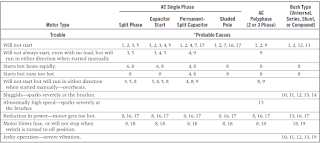 |
| Guide to Probable Causes of Motor Troubles |
*Probable causes
1. Open in connection to line 10. High mica between commutator bars
2. Open circuit in motor winding 11. Dirty commutator or commutator is out of
3. Contacts of centrifugal switch not closed 12. Worn brushes and/or annealed brush springs
4. Defective capacitor 13. Open circuit or short circuit in the armature winding
5. Starting winding open round rotating members 14. Oil-soaked brushes
6. Centrifugal starting switch not opening 15. Open circuit in the shunt winding
7. Motor overloaded 16. Sticky or tight bearings
8. Winding short-circuited or grounded 17. Interference between stationary
9. One or more windings open 18. Grounded near switch end of winding 19. Shorted or grounded armature winding
Lubricating Sleeve-Bearing Motors
Sleeve-bearing motors are quieter than ball-bearing motors. They operate by having a small tube-like (brass, bronze, or alloy) sleeve support the rotor shaft at each end. The lubricant used with sleeve bearings must actually provide a film that completely separates the bearing surfaces from the rotating shaft member and ideally eliminates all metal-to-metal contact.
Choice of Lubricant
Good lubricants are essential to low maintenance costs. Oil that provides the most effective bearing lubrication and does not require frequent renewal should be selected. In general, low-viscosity oils are recommended for fractional horsepower motors because they offer low friction, permit fuller realization of the motors’ efficiency, and minimize the operating temperature of the bearing. Top-grade oils are recommended, since they are
1. Refined from pure petroleum
2. Substantially non-corrosive to metal surfaces
3. Free from sediment, dirt, or other foreign materials
4. Stable in the presence of heat and moisture encountered in the motor
In terms of performance, the higher-priced oils often prove to be cheaper. If extremes in bearing temperatures are expected, special care should be exercised in selecting the proper lubricant. Special oils are available for motor applications at high temperatures and low temperatures. Standard-temperature-range oils should not be used in situations with high ambient temperatures and high motor-operating temperatures because there will be
- Decrease in viscosity
- Increase in corrosive oxidation products, and
- Usually a reduction in the quantity of lubricant in contact with the bearing
This, in turn, will cause an increase in bearing temperature and a damaging effect on bearing life and motor performance.
Prevention of Wear
Sleeve-bearing motors are less susceptible to wear than ball bearing motors because the relatively soft surface of the sleeve bearing can absorb hard particles of foreign materials. Therefore, there is less abrasion and wear. However, good maintenance procedures for both types of motors require that the oil and bearings be kept clean.
How often the oil should be changed depends on local conditions, such as the severity and continuity of service and operating temperatures. A conservative lubrication maintenance. program should call for inspection of the oil level and cleaning and refilling with new oil every 6 months.
Warning
Over lubrication should be avoided at all times. Excess motor lubricant is a common cause of the failure of motor winding insulation in both sleeve and ball-bearing motors.
Danger Signals
There are danger signals that usually appear before a motor overheats or burns out. At first appearance of these signs, the electrician or apprentice should make every effort to correct and improve maintenance procedures and remedy any other problems to try to avoid permanent damage to the bearings or motor.
Major Danger Signals in Ball-Bearing Motors
- A sudden increase in the temperature differential between the motor and bearing temperatures usually indicates malfunction of the bearing lubricant.
- A temperature higher than that recommended for the lubricants warns of a reduction in bearing life. (A good rule of thumb is that grease life is halved for each 25° increase in operating temperature.)
- An increase in bearing noise, accompanies an increase in bearing temperature indicating a serious bearing malfunction.
Major Causes of Ball-Bearing Failure
- Foreign matter in the bearing from dirty grease or ineffective seals
- Deterioration of grease because of high temperatures or contamination
- Overheating caused by too much grease
Major Danger Signals in Sleeve-Bearing Motors
- Rumbling noise
- High-pitched whistling sound
Common Motor Troubles and Their Causes
When troubleshooting an electric motor, it is advisable to keep in mind the most common problems associated with a particular type of motor. With a fractional-horsepower motor, easy-to-detect symptoms indicate exactly what is wrong in many cases. However, at times, several types of problems have similar symptoms, and it becomes necessary to check each symptom separately to diagnose the overall problem. Table lists some of the more common problems of small motors along with suggestions of possible causes.
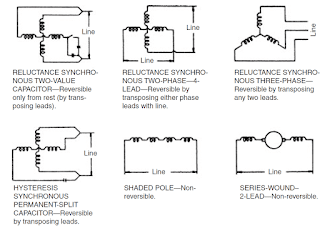 |
| Connection diagram – Electric motor Troubleshooting 1.1 |
Most common motor troubles can be checked by some tests or by visual inspection. The order in which to conduct these tests rests with the troubleshooter, but it is natural to conduct the simplest tests first. For instance, when a motor fails to start, you first inspect the motor connections, since this is an easy and a simple thing to do. In some cases, a combination of symptoms will provide a clue to the source of trouble and eliminate some possibilities.
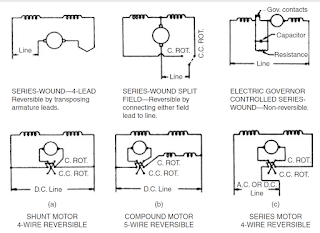 |
| Connection diagram – Electric motor Troubleshooting 1.2 |
For example, in the case cited previously a motor will not start if heating occurs, this fact suggests that a short or ground exists in one of the windings and eliminates the likelihood of an open circuit, poor line connection, or defective starter switch. Centrifugal starting switches, found in many types of fractional horsepower motors, are occasionally a source of trouble. If the mechanism sticks in the run position, the motor will not start once it is turned off. On the other hand, if the switch sticks in the closed position, the motor will not attain speed and the start winding quickly heats up.
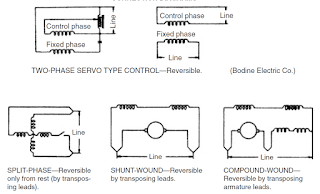 |
| Connection diagram – Electric motor Troubleshooting 1.3 |
The motor may also fail to start if the contact points of the switch are out of adjustment or coated with oxide. It is important to remember, however, that any adjustment of the switch or contacts should be made only at the factory or at an authorized service station. Knowing the arrangement of coils aids in checking for possible
1. Shorts
2. Grounds
3. Opens
In any type of alternating current (AC) or direct current (DC) motor. Figure shows these motor connections.
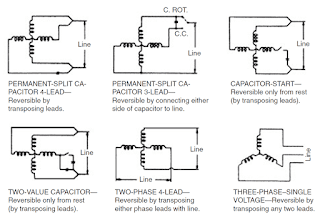 |
| Connection diagram – Electric motor Troubleshooting 1.4 |
Knowing the current expected to be drawn in the normal operation of a motor also aids in troubleshooting. Then it is possible to use a clamp-on ammeter, check the current drawn by the motor, and compare it with the standards to see if it is excessive or otherwise incorrect. Table shows these ampere ratings of AC motors that operate on three-phase power. Remember, however, that these are average ratings and that the rating on the specific motor
could be higher or lower.
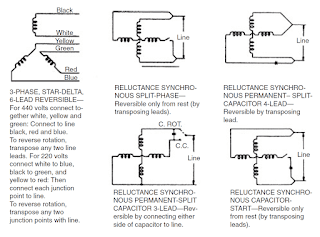 |
| Connection diagram – Electric motor Troubleshooting 1.5 |
Therefore, the selection of heater coils on this basis alone involves some risk. For fully reliable motor protection, check the motor’s nameplate and select heater coils based on the full-load current rating given in this section.
Safety Precautions – Electric Motor Troubleshooting
When working with motors, it is important that certain safety procedures be followed at all times.
1. Be sure that all motor installation, maintenance, and repair work is performed only by qualified people.
2. Disconnect and lock all input power before doing any work on motors or any electrical equipment.
3. Whenever equipment is to be lifted, follow the specific procedures for using the lift bail.
4. Follow the National Electrical Code (NEC) rules and all local codes when installing any electrical equipment.
5. Be sure that all equipment is properly grounded in accordance with the NEC.
6. Keep hands, hair, clothing, and tools away from all moving parts when operating or repairing equipment.
7. Provide proper safeguards to prevent contact with rotating parts.
8. Be familiar with and adhere to recommendations outlined in Safety Standards for Construction and Guide for Selection, Installation and Use of Electric Motors and Generators (NEMA MG-2).
Warning: When Using Lift Bail
Do not use the lift bail on the motor to lift the motor along with additional equipment, such as
- Pumps
- Compressors
- Other driven machinery
In the case of assemblies on a common base, do not lift the motor by the lift bail, but rather use a sling around the base or the lifting means provided on the base. In all cases, take care to ensure lifting only in the direction intended in the design of the lifting means. Also, be careful to avoid hazardous overloads due to deceleration, acceleration, or shock forces.
Troubleshooting Posts:
- Wiring Problems Troubleshooting General
- Electrical Problems Troubleshooting
- Fluorescent Lamp Troubleshooting Tips
Final Word
Hope you understand this article about the Types and uses of Electric Motor Maintenance and Troubleshooting. Incase of any doubt please comment below. Subscribe our website to get every new post update to your email. Please follow our website @ElectricianWorld.Net for future updates. Thank you for visiting our website.




I never knew that make sure a motor is correctly rated if it is utilized in various settings or in a different way. I never thought that it would be like this, I’ll share this with my aunt. Thank you for the information about the electric motor repair.